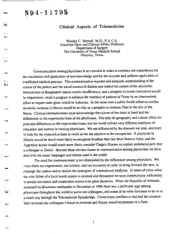
NASA Technical Reports Server (NTRS) 19940007323: Clinical aspects of telemedicine PDF
Preview NASA Technical Reports Server (NTRS) 19940007323: Clinical aspects of telemedicine
N94-11795 --. m Clinical Aspects of Telemedicine Ronald C. Merrell, M.D., F.A.C.S. Associate Dean and Clinical Affairs Professor Department of Surgery The University of Texas Medical School Houston, Texas = -i. i Communication among physicians is an essential in order to combine our experiences for the elucidation and application of new knowledge and for the accurate and uniform application of established medical practice. This communication requires and adequate understanding of the U culture of the patient and the social context of disease and indeed the culture of the physician. Malnutrition in Bangladesh means caloric insufficiency, and a program to lower cholesterol would be impertinent, while a program to enhance the nutrition of patients in Texas by an international effort to import more grain would be ludicrous. In the same vein a public health effort to combat alcoholic cirrhosis in Mecca would be as silly as a program to increase fiber in the diet of the Bantu. Clinical communication must acknowledge the culture of the issue at hand and the differences in the experiential base of the physicians. Not only do geography and culture affect the potential differences in the experiential bases, but the world utilizes very different traditions of education and science in training physicians. We are influenced by the diseases we treat, and learn to look for the expected at least as much as we are attentive to the unexpected. A physician in Siberia would be much more likely to recognize frostbite than one from Buenos Aires, and the Argentine doctor would much more likely consider Chaga's Disease to explain abdominal pain than a colleague in Zurich. Beyond these obvious issues in communication among physicians we must deal with the many languages and idioms used in the world. The need for communication is not diminished by the differences among physicians. We must share our experiences, our science, and our humanity in order to bring forward the new, to expunge the useless and to realize the synergism of international medicine. In times of crisis when the very fabric of a local health system is strained and threatened we must communicate sufficiently to permit assistance and cooperation across even great distances. When the Republic of Armenia sustained its disastrous earthquake in December of 1988 there was a profound urge among w physicians throughout the world to assist our colleagues, and some of us were fortunate to do so in a small way through the Telemedicine Spacebridge. I have every confidence that had the situation been reversed the colleagues I found in Armenia and Russia would reciprocate in a flash. mm Therefore,I believewemustexaminetheexperiencewesharedinordertoprepareforthenext I inevitabledisaster. ThemajorcharacteristicoftheTelemedicinSepacebridgewasmedicalcommunication.The m equationofthecommunicationbroughtintorelationshipconsultingphysiciansinArmeniawhohad primaryresponsibilityforthepatienisfindc-on--antphySiciansintheUnitedStates.Thefeatures U oftheconsultingphysicianswhichwereimportantforsuccessincludedfull recognitionofthe experientialdifferencesbetweenoursystems+'o_tucation, ourpractice,ourcultureandlanguage. I At thatpointitwasimportantfortheconsultingphysicianastheinitiatoroftherelationshipto identifytheproblemsweshoulddiscuss.Thisrequiredgreatunderstandingoftheclinicalproblem asrecognizedinArmeniaandthe_gof thequestiontobediscussedwithgreatclarity. Given m thecomplexityofthedifferencesinexperienceandpractice,thequestionrequiredaveryclear i formatforpresenta_on0f_e back_oun_o_'_thpeatien__d ai/uUknowledgeofthetechnologywe woulduseforthecommunication.Thecommunicationitselfwouldentailwordsinprintand _ I imagesandsoundswhichthenweretobeprocessedattheotherendintoaccurateconceptswhich n wereassimilaraspossibletotheoriginalconceptoftheconsultingphysician.Whenthe consultantrespondeditwasimperativethattheConsultingphysicianunderstandtheresponsewith i referencetotheissueorthepatientathandandthattheconsultingphysicianhaveconfidenceinthe consultant.Thiskindofconfidenceisnormallydevelopedoveryearsamongcolleaguesin agiven specialty,butin thiscasetheco_dencewasneededpromptly._ ordertoaccomplishthisthere wasavarietyofconferencestoshareexperienceandexpertisew, hichestablishedthepeer relationshipamongtheparticipatingphysicians.Credentialswerealsoofferedandcredibilitywas m bolsteredbyofferingasmuchinthewayofpersonalpublishedinformationaspossible.Inorder forthecommunicationtosatisfythetestofusefulnesstheconsultingphysicianhadtobewilling to nm considerchangingtheapproachandmanagemenotfaparticularpatient.Withoutagenerous willingnesstoincorporatethenewinformationintoactioninpatientcarethepurposeofthe im communicationinreferencetotheactualmedicaldisasterwouldhavefailed. Thefeaturesrequiredoftheconsultanpthysicianwerequitesimilar,asonemightexpect,to ili thoseof theconsultingphysicianif theobjectivewasanequationorrelationshipwhichwouldlead toimprovedpatientcare.Certainlytheconsultantneededtounderstandthegenericproblemsof patien foltowing'the _s_ter _dt-0_have Sufficientexpertise t0_ awo_while collaborator. The consultant was required to adequately understand the question and to recreate the concept of the 3 consulting physici_ in0rd_ io's_0n -_e C0_ncet0-resp0ndto the question with tI information that might be translated into a new management plan for a patient the consultant would never see. This sense of personal responsibility on the part of the consultant to at least approximate that of the primary treating physician in Armenia was critical to the relationship. The I 2 consultant also had to be willing to abandon preconception and incorporate new knowledge contributed by their Armenian counterpart into the response. w The overriding feature of the relationship was one of professional trust, employing the mediation of an extraordinary technology. It was clear from the outset that the technology was not an end to itself but a conduit for the engendering of professional trust and reliance. The proof of effectiveness was to be the implementation of useful clinical activities developed by new colleagues in apeer relationship of international medicine. I L w ! i / I ! I ql if i m if i i ailD i i i a i i, II
